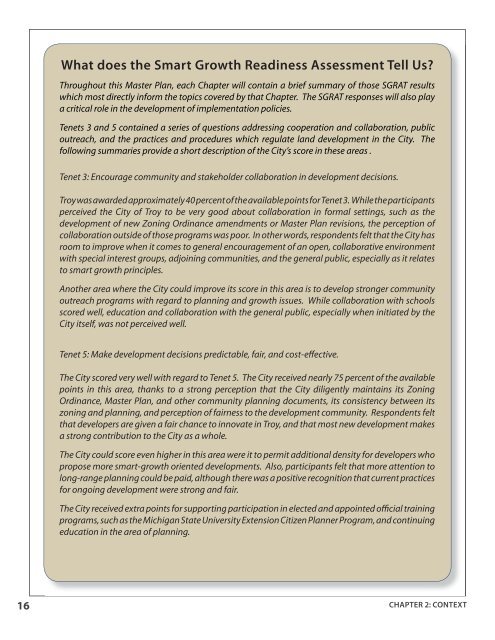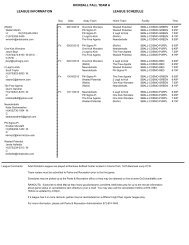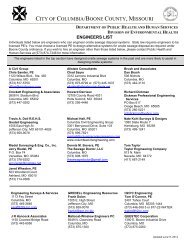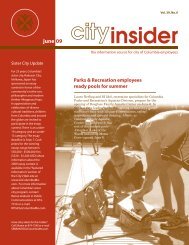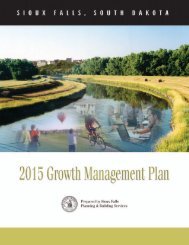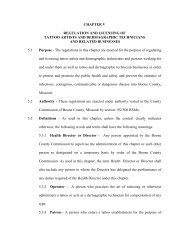Master Plan - City of Troy
Master Plan - City of Troy
Master Plan - City of Troy
You also want an ePaper? Increase the reach of your titles
YUMPU automatically turns print PDFs into web optimized ePapers that Google loves.
What does the Smart Growth Readiness Assessment Tell Us?Throughout this <strong>Master</strong> <strong>Plan</strong>, each Chapter will contain a brief summary <strong>of</strong> those SGRAT resultswhich most directly inform the topics covered by that Chapter. The SGRAT responses will also playa critical role in the development <strong>of</strong> implementation policies.Tenets 3 and 5 contained a series <strong>of</strong> questions addressing cooperation and collaboration, publicoutreach, and the practices and procedures which regulate land development in the <strong>City</strong>. Thefollowing summaries provide a short description <strong>of</strong> the <strong>City</strong>’s score in these areas .Tenet 3: Encourage community and stakeholder collaboration in development decisions.<strong>Troy</strong> was awarded approximately 40 percent <strong>of</strong> the available points for Tenet 3. While the participantsperceived the <strong>City</strong> <strong>of</strong> <strong>Troy</strong> to be very good about collaboration in formal settings, such as thedevelopment <strong>of</strong> new Zoning Ordinance amendments or <strong>Master</strong> <strong>Plan</strong> revisions, the perception <strong>of</strong>collaboration outside <strong>of</strong> those programs was poor. In other words, respondents felt that the <strong>City</strong> hasroom to improve when it comes to general encouragement <strong>of</strong> an open, collaborative environmentwith special interest groups, adjoining communities, and the general public, especially as it relatesto smart growth principles.Another area where the <strong>City</strong> could improve its score in this area is to develop stronger communityoutreach programs with regard to planning and growth issues. While collaboration with schoolsscored well, education and collaboration with the general public, especially when initiated by the<strong>City</strong> itself, was not perceived well.Tenet 5: Make development decisions predictable, fair, and cost-effective.The <strong>City</strong> scored very well with regard to Tenet 5. The <strong>City</strong> received nearly 75 percent <strong>of</strong> the availablepoints in this area, thanks to a strong perception that the <strong>City</strong> diligently maintains its ZoningOrdinance, <strong>Master</strong> <strong>Plan</strong>, and other community planning documents, its consistency between itszoning and planning, and perception <strong>of</strong> fairness to the development community. Respondents feltthat developers are given a fair chance to innovate in <strong>Troy</strong>, and that most new development makesa strong contribution to the <strong>City</strong> as a whole.The <strong>City</strong> could score even higher in this area were it to permit additional density for developers whopropose more smart-growth oriented developments. Also, participants felt that more attention tolong-range planning could be paid, although there was a positive recognition that current practicesfor ongoing development were strong and fair.The <strong>City</strong> received extra points for supporting participation in elected and appointed <strong>of</strong>ficial trainingprograms, such as the Michigan State University Extension Citizen <strong>Plan</strong>ner Program, and continuingeducation in the area <strong>of</strong> planning.16 CHAPTER 2: CONTEXT


